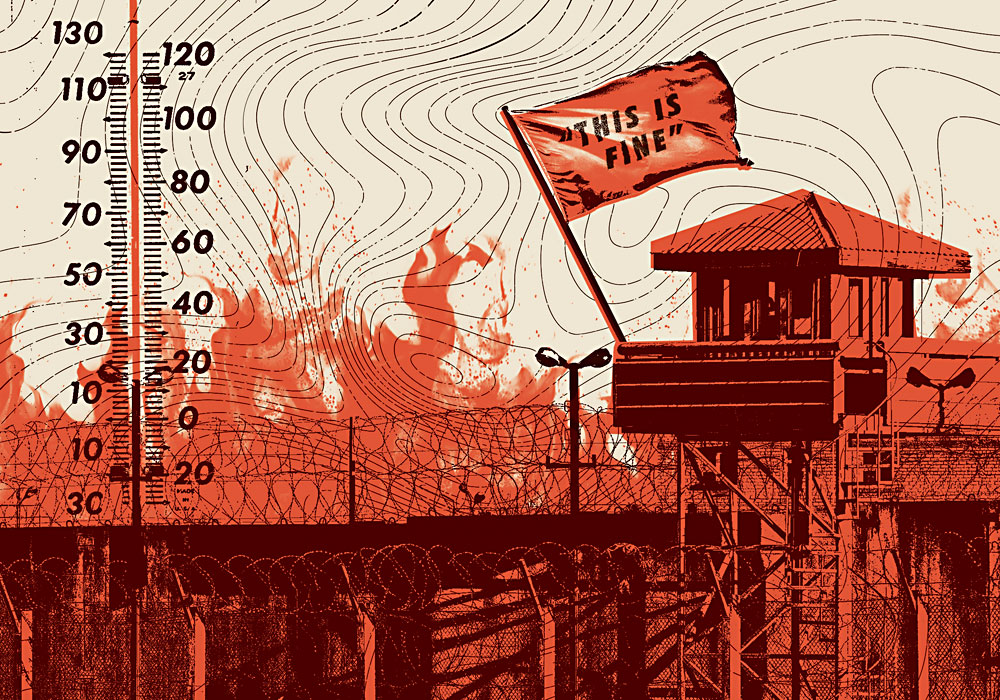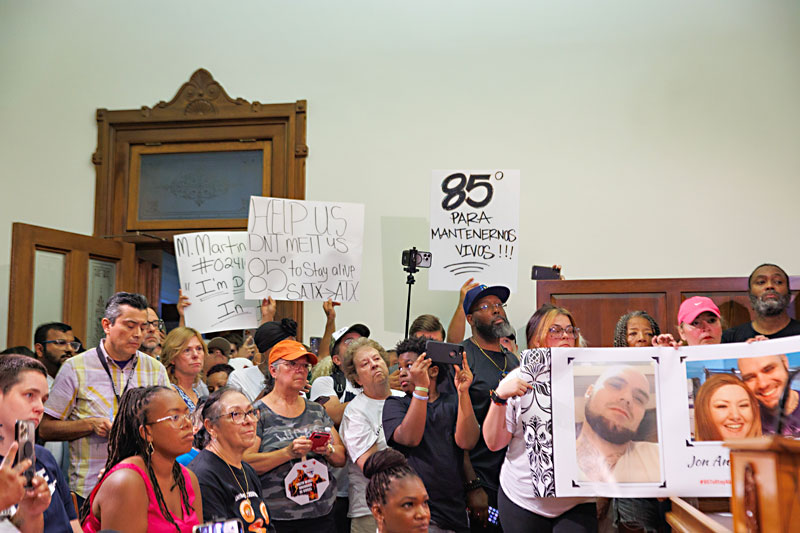This is part 2 of a three-part series on the dangerous heat in the two-thirds of state prisons that lack air conditioning. Next week, we’ll dive into what prisoners and advocates are demanding from the state.
The thermometer had been installed high up on the wall and covered by a piece of black electrical tape so the prisoners couldn’t read it. Marci Simmons and her fellow inmates were surviving another summer of extreme heat in the Dr. Lane Murray Unit, a prison without air conditioning. They knew the temperature was hotter than 100 degrees. They wanted to know how much hotter.
“It was too high without a ladder,” Simmons said. “So we took a couple of Maxi pads and turned them inside out, so the sticky side was out, and put them on a mop handle. And I climbed up on this big industrial fan, with two of the girls holding it, and rolled back the tape. And it was 136 degrees.”
136 degrees is a suffocating level of heat. It’s what you feel when you enter a car that has been sitting in the sun for hours, with a steering wheel too hot to touch. But this is the kind of heat that inmates in two-thirds of the state’s prisons – about 95,000 people – have been enduring this summer, according to their family members and supporters. Prison advocates believe the heat has killed at least 12 inmates since June and sickened dozens, if not hundreds, more.
The Texas Department of Criminal Justice, which runs the prisons, disagrees. Department spokesperson Amanda Hernandez told us there have been no heat-related deaths this summer and only nine inmates have required medical treatment beyond first aid. (Meanwhile 25 employees have required such aid, though prisoners outnumber corrections officers 7 to 1.) “We take numerous precautions to lessen the effects of hot temperatures,” Hernandez wrote in a response identical to ones she has shared with other media outlets. “These efforts work.”
In fact, TDCJ has not admitted to a single heat-related death in its prisons since 2012. That year, the department acknowledged that 10 inmates had died during the historically hot summer of 2011, which, at the time, was the hottest in 75 years (though this summer is breaking many of the heat records set then). The acknowledgment led to a series of wrongful death lawsuits. It also led to Cole vs. Collier, a suit filed by inmates of the Wallace Pack Unit near College Station, which houses older prisoners and those in bad health. The plaintiffs in the Pack lawsuit, diagnosed with diabetes, heart disease, and obesity – conditions that made them more vulnerable to extreme heat – asked the court to force TDCJ to install AC in the prison, saying the conditions there constituted cruel and unusual punishment.
Elected officials, community members, and advocates hold a press conference at the Texas Capitol July 18, demanding emergency action to address deadly heat in Texas prisons (photo by Jana Birchum)
TDCJ responded that the ice and fans it provided the prisoners in the summer months were enough to keep them safe. But in 2017, Judge Keith Ellison ruled that the conditions at Pack were analogous to torture, that TDCJ was “deliberately indifferent” to the suffering of its inmates. “The Court finds that, despite a significant risk of harm faced by the men at the Pack Unit, [TDCJ has] done the bare minimum,” the judge wrote. “They have implemented mitigating measures that they know, or should know, are ineffective given the extreme heat at the Pack Unit, and they have failed to consider seriously the many more effective options available to them.”
“If it’s 100 degrees outside, it’s 120 in here, but you can’t have your shirt off, you got to wear the cotton uniforms they give you.”
–Isaiah May, prisoner in the Holliday Unit
TDCJ’s defense and settlement of the Pack lawsuit cost taxpayers $7 million dollars. When AC was finally installed, it cost only $4 million. The suit demonstrated how far TDCJ was willing to go to deny that any problem existed. For example, the department presented a doctor at trial who testified that heat cramps and heat exhaustion are not serious conditions. In fact, heat-related illnesses kill more Americans each year than hurricanes, lightning, and any other natural disasters, combined.
After the lawsuit was settled in 2018, TDCJ enacted new policies to move elderly and medically vulnerable inmates to air-conditioned prisons. But it didn’t ask state legislators to fund the installation of AC in its other prisons.
Instead, the department doubled down on the policies that Ellison had described as the bare minimum, requiring guards to provide ice water, fans, and extra showers to inmates in the summer months. It emphasized that inmates who felt in danger of overheating could be moved to air-conditioned areas of the prison, like the chapel or barbershop, until they cooled off, a measure known as “respite.”
But with TDCJ’s ongoing, statewide staff shortage, our sources tell us that many prisons aren’t capable of following the policy. Tiffany Turner said her husband, incarcerated at the Polunsky Unit in far East Texas, is only getting cold water sporadically. “He said maybe they will get it once a day and, if they get it, there’s no ice, it’s just water that’s a little better than lukewarm,” Turner said. “He said with it being so hot, a lot of the staff are calling in. They don’t want to be there.”
Turner told us the staffing crisis has made respite almost nonexistent at Polunsky. Kat Comisky‘s husband, who was recently released from the Estelle Unit, said the same is true there and that some guards arbitrarily deny respite. “He’s seen people ask, ‘Can I go to respite?’ And certain guards will just say no. He said it all depends on the guard.”
We’ve also heard repeatedly that respite is crowded and uncomfortable. “Respite is supposed to be a place with air conditioning that you can go to for 30 minutes if you feel like you’re going to faint or throw up,” said Samantha Woods, whose daughter, Alexis, is at Lane Murray. “But this is a room that fits 18 people and it has a tiny portable A/C unit in it that does nothing. And the room will be packed with inmates. So the body heat coming off them is just ridiculous. The inmates have to sit on the floor and be silent to get 30 minutes of cool air and then be shoved back out into the oven.”
Inmates who use wheelchairs and walkers avoid respite, we’re told, because it’s difficult for them to sit on the floor. These inmates remain in their cells with their personal, palm-sized fans set on high. TDCJ touts the effectiveness of these fans but many regard them as worthless. “The heat gets to a certain temperature where the fans are just blowing hot air,” said Angela Gonzalez, whose husband is at the Jim Ferguson Unit. “Most of the men are dehydrated because they can’t get to a healthy level of hydration due to all of the sweating. Their stomachs cramp up and it becomes difficult to eat.”
The sweating is necessary, of course. When it stops, the inmate dies. Isaiah May, incarcerated at the Holliday Unit, said he and his fellow inmates are constantly soaked. “If it’s 100 degrees outside, it’s 120 in here, but you can’t have your shirt off, you got to wear the cotton uniforms they give you. When you go to the chow hall, they close the doors and there’ll be 200 inmates sitting in that chow hall for an hour, soaking wet with sweat.”
May said he has a heat rash covering his arms. Woods’ daughter has a heat rash, too. “She is in a state of perpetual dripping sweat. She doesn’t sit down, if she does she’s sitting in a puddle of sweat. And yeah, there’s heat cramps and migraines and trouble breathing – all that stuff is going on. But the authorities don’t care. And nobody on the outside knows what’s happening.”
Got something to say? The Chronicle welcomes opinion pieces on any topic from the community. Submit yours now at austinchronicle.com/opinion.
This post was originally published on this site be sure to check out more of their content.










